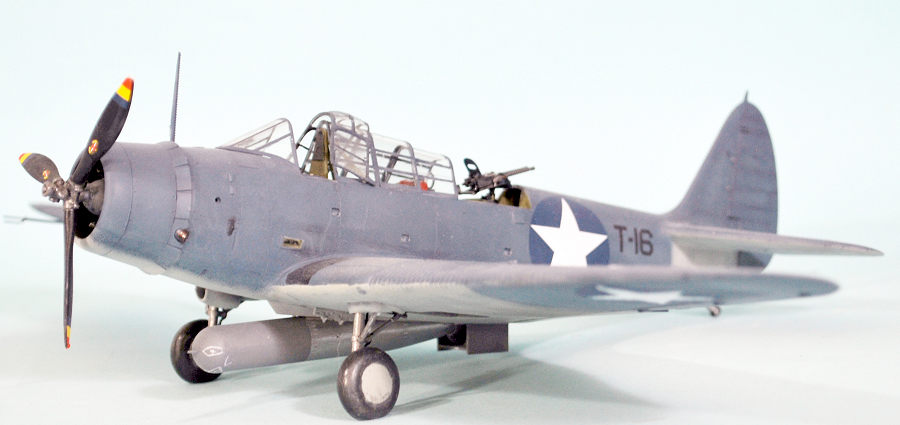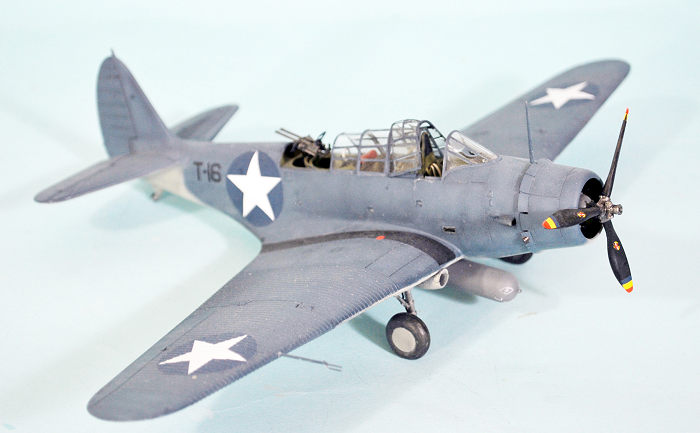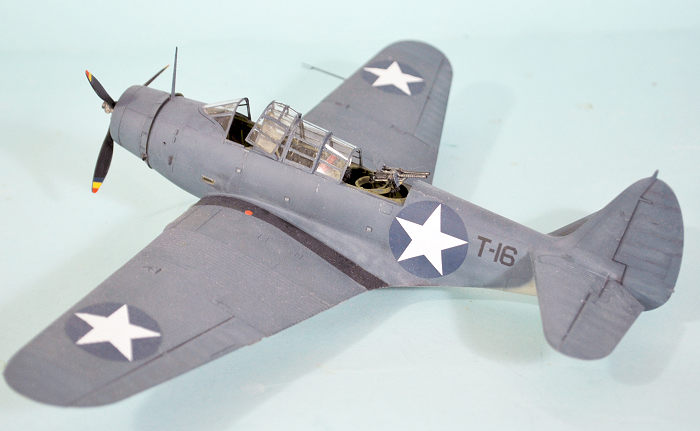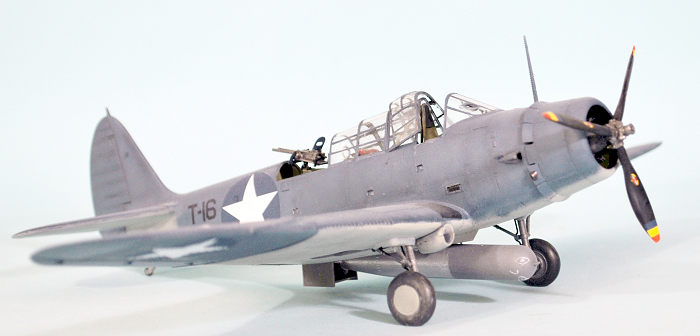
| KIT #: | L4807 |
| PRICE: | $42.00 on discount |
| DECALS: | Two options |
| REVIEWER: | Tom Cleaver |
| NOTES: |

| HISTORY |
Unfortunately for the U.S. Navy, the Bureau of Naval Ordnance, which was responsible for developing torpedoes - seen as the most effective weapon against ships - did more damage to naval aviation than the enemy did. The original torpedoes were delicate and vulnerable to the slightest damage. As a result, the aircraft created to use the weapon were forced to make attacks at an altitude of 100 feet and an airspeed no greater than 100mph, flying straight and level. An attack under those conditions was so dangerous that during World War II any naval aviator who dropped a torpedo in an attack on an enemy ship - regardless of success or failure, was automatically awarded a Navy Cross. The Mark XII was the worst torpedo used by any navy, with low speed, short range and an unreliable trigger.
While the Bureau of Ordnance was busy screwing the pooch in the field of torpedo development, the naval aviators at the Bureau of Aeronautics achieved a breakthrough in the development of carrier based aircraft in 1934 when the specifications included in the request for a modern torpedo bomber to replace the thoroughly-obsolete Martin T4M-1 biplane (also produced as the Great Lakes BT-1) used by varrier-based torpedo squadrons since 1930. While a monoplane wasn’t specified since such a demand would never make it past the conservatives who ran the Navy, the specification was such that a biplane would have difficulty in meeting the required performance.
Douglas responded with a modern, all metal, low-wing monoplane design that was in advance of all other carrier-based aircraft anywhere in the world. Ordered as the TBD-1, the XTBD-1 prototype first flew in 1935. Powered by a 900 h.p. Pratt and Whitney R-1830, the clean three-seat aircraft had a then-phenomenal top speed of just over 200 mph. Trials in 1936 demonstrated its compatibility with all Navy fleet carriers. In 1937, production of 129 TBD-1 “Devastator” aircraft began, finishing in 1939 and all six of the carrier air groups.
 Unfortunately,
development did not include using the newer, high-powered R-1830, which had
1,200 h.p. by 1938. The TBD was underpowered as a result, and sluggish in
performance when mated to a 2,000-lb torpedo; Dick Best remembered it as a
“nice-flying airplane” when not so burdened. Torpedo squadrons were
considered so important, and the cachet of flying the most modern carrier
aircraft in the world was such that even such a skilled aviator as Best had
to “settle” for assignment to dive bombers in 1940.
Unfortunately,
development did not include using the newer, high-powered R-1830, which had
1,200 h.p. by 1938. The TBD was underpowered as a result, and sluggish in
performance when mated to a 2,000-lb torpedo; Dick Best remembered it as a
“nice-flying airplane” when not so burdened. Torpedo squadrons were
considered so important, and the cachet of flying the most modern carrier
aircraft in the world was such that even such a skilled aviator as Best had
to “settle” for assignment to dive bombers in 1940.
The revolution in aircraft design performance that epitomized the decade before the outbreak of World War Two was such that the TBD that had been the cutting edge of naval aviation in 1936 was obsolescent five years after its appearance on a carrier deck. Its replacement, the Grumman TBF, was already in prototype development at the time of US entry into the war.
While the TBD is remembered as a “flying target” due to its performance at the Battle of Midway, when it was used correctly, in coordinated attacks with high-altitude dive bombers and with proper fighter escort, it was successful. At the Battle of the Coral Sea, Devastators from Lexington and Yorktown sank the light carrier Shoho and damaged both Shokaku and Zuikaku such that they were unable to participate in the Battle of Midway. The TBD was sent into battle at Midway without the diversion of dive bomber attacks and without fighter escort, allowing the defending Japanese fighters to go after them without competition. That they would be slaughtered as a result was something that should not have surprised anyone. Even the TBF, the Devastator’s replacement, lost 3 of 4 attacking aircraft during the battle and the sole survivor never flew again.
Torpedo Eight at Midway:
Hornet CAG Commander Stanhope Ring had graduated first in his Annapolis class in 1923. A by-the-book officer who had never shown interest in challenging the rules even when necessary, he was not well-respected as an aviator or leader by the air group’s pilots. When planning the Midway mission, Ring informed his squadron commanders that the group would assemble as a whole before they headed out, and that the Wildcat escorts would stay high with the dive bombers. Torpedo squadron commander LCDR John Waldron argued that the fighters should be divided as they were at Coral Sea, with two divisions low to protect the vulnerable Devastators. Ring also decided to head directly west, rather tan north-northwest, the more direct route to the enemy. Waldron disagreed and the argument went as high as Hornet’s Captain Marc Mitscher, who sided with Ring against Waldron.
 Hornet’s
air group broke up shortly after Ring took his westerly heading of 265
degrees at the head of the dive bombers. Waldron signaled his pilots to
follow him and took up a heading of 240 degrees, the most direct course to
the enemy.
Hornet’s
air group broke up shortly after Ring took his westerly heading of 265
degrees at the head of the dive bombers. Waldron signaled his pilots to
follow him and took up a heading of 240 degrees, the most direct course to
the enemy.
An hour into their flight, Waldron spotted a strange plane that suddenly appeared to his rear. The stranger made no attempt to close on the Devastators. It was the Tone No. 4 scout; it warned the fleet: “Fifteen enemy planes are heading toward you.”
Having taken the most direct course, Waldron spotted Kido Butai shortly after his spread-out search formation spotted smoke on the horizon at 0925 hours.
Unfortunately, his call to Stanhope Ring came too late. The Hornet CAG took the dive bombers and fighters out to their maximum range, and missed the enemy entirely. Prewar carrier doctrine called for a strike force to return to the nearest friendly land base. That meant a turn south to Midway. Ring had required a “parade ground” formation, which meant increased gas usage; it was questionable the planes had fuel to get to Midway. Some SBDs and F4Fs tried to return to Hornet, while the others headed toward Midway. Most of the SBDs made it; only two of the 10 Wildcats returned. Ring’s decision removed Hornet from the battle and nearly cost Marc Mitscher his career, had he not already received notice of promotion to Rear Admiral.
Torpedo Eight had been accidentally escorted by fighters from Enterprise; when Waldron turned northwest, Lieutenant James Gray,VF-6s new CO, continued west since he was not on the same frequency and had not heard Waldron’s order. The Devastators were now completely alone. Waldron pushed into a dive, followed by the others. They took up attack formation at 60 feet, heading toward the enemy carriers alone.
Waldron turned to attack the southernmost carrier. The TBDs were 16,000 yards from the target when 30 Zeros of the Combat Air Patrol swarmed the formation. The first Devastator fell from the left side of the formation in flames. Ensign George Gay later reported he heard Waldron ask his gunner, Aviation Radioman 1/c Horace Dobbs, if the burning plane was a torpedo bomber or a fighter. The radioman in a distant PBY heard his indistinct words, “Watch those fighters! … My two wingmen are going into the water….”
The Zeros struck the formation again. Waldron’s left wing was hit, rupturing the fuel tank as the wing caught fire. He was last seen standing in his cockpit as he tried to get out, just before the Devastator hit the water, then disappeared into the depths.
 Gunners
on the cruisers Tone and
Chikuma opened fire when the planes flew
past. By the time the bombers were past the cruisers, only six were left.
Fleet defensive fire put up a curtain of fire. One by one, five TBDs were
hit and crashed into the sea.
Gunners
on the cruisers Tone and
Chikuma opened fire when the planes flew
past. By the time the bombers were past the cruisers, only six were left.
Fleet defensive fire put up a curtain of fire. One by one, five TBDs were
hit and crashed into the sea.
George Gay later remembered that just after the last of the TBDs went down, he heard his gunner, Aviation Radioman 3/c Bob Huntington, call out over the intercom, “They got me sir.” He glanced back and saw his gunner slumped over his guns. Gay turned toward what he identified as the Kaga, though later research determined he was headed toward the wildly-evading Soryu. He maneuvered to come in on her port bow. A glance over his shoulder revealed a sky full of enemy fighters trying to close on him. 800 yards from the carrier, he dropped his torpedo. The TBD lifted from the loss of weight and he flew directly over the stern. Once past, he was hit by more fire and the first of five attacking Zeros. A 20mm shell flash-burned his left leg. A second Zero attacked and another shell fragment hit his left hand while a bullet hit his upper left arm. The stick went slack in his hand and the rudder pedals fell away. With its controls destroyed, the bomber pancaked out of control into the ocean a quarter mile behind the carrier Gay had attacked. As it struck the water, the hood slammed shut over the cockpit. The plane tipped for its final dive as Gay struggled to open the canopy. “I couldn’t get it open. That’s when I got scared.” Finally the hood slid back and he scrambled out as it took its final dive. He was left bobbing in the sea; a moment later his seat cushion popped up a yard from him.
| THE KIT |
The initial release of he Great Wall Hobby TBD received some strong criticism, not least from yours truly. The company took the criticism to heart and revised the kit, most prominently adding in landing gear “under a load,” so the model would sit right.
| CONSTRUCTION |
GWH’s revisions to this kit meant that all the instructions I gave in my first review of how to avoid the designed-in problems were moot this time. Construction was easy, following the instructions.
With the new Trumpeter TBD now arriving on modelers’ doorsteps, those with detailed knowledge of the airplane are bringing up new information. Dana Bell has just submitted a new book on the airplane that Squadron will publish next month, and from what I have learned recently, you will be well advised to pick that up.
 Lynn
Ritger published two items of note: the first is that the TBD cockpits were
originally in aluminum lacquer, but a BuAer directive of March 1939 directed
they be repainted Bronze Green when in for major overhaul. Photographic
evidence - most prominently the photos of the VT-2 TBDs sitting on the
bottom of the Coral Sea for the past 80 years - shows this was done. I
learned this just after I had completed this model, so mine is incorrectly
done in “Interior Green.” If you’re doing this kit or its Trumpeter big
brother (which is scaled up from this kit the way Trumpeter scaled up the
Accurate Miniatures SBD for their 1/32 kits), you want to paint the cockpit
overall Bronze Green.
Lynn
Ritger published two items of note: the first is that the TBD cockpits were
originally in aluminum lacquer, but a BuAer directive of March 1939 directed
they be repainted Bronze Green when in for major overhaul. Photographic
evidence - most prominently the photos of the VT-2 TBDs sitting on the
bottom of the Coral Sea for the past 80 years - shows this was done. I
learned this just after I had completed this model, so mine is incorrectly
done in “Interior Green.” If you’re doing this kit or its Trumpeter big
brother (which is scaled up from this kit the way Trumpeter scaled up the
Accurate Miniatures SBD for their 1/32 kits), you want to paint the cockpit
overall Bronze Green.
Lynn’s second important discovery was a copy of the VT-3 after-action report, which references the gunners having twin-30 mounts. All three squadrons at Midway had been re-equipped jut before departure from Hawaii with the twin gun mount. Many of the airplanes completely dispensed with the canopies for the gunner’s position, since they could not be closed over the mount. This saves you trying to force-stack the canopies or having to buy the Squadron vacuform; the pilot’s canopy in the kit parts can be slid over the rest of the greenhouse without trouble.
| COLORS & MARKINGS |
 If you are
doing a Midway VT-8 TBD, available photos show these were pretty clean. They
hadn’t seen a lot of operation, certainly nothing to sun-fade them.
Consulting the color film of VT-8, I used Gunze-Sangyo H-42 Blue-Gray
(primary) for the upper color, going over it with thinned Mr. Color C367
Blue-Gray (US Navy aircraft), which is too light for the base but good when
mixed in for a bit of fading. I used H338 Light Gray (US Navy Aircraft) for
the lower color. If you’re doing a VT-3 or VT-6 airplane, these were worn
and faded, so use more C367 for post-shading.
If you are
doing a Midway VT-8 TBD, available photos show these were pretty clean. They
hadn’t seen a lot of operation, certainly nothing to sun-fade them.
Consulting the color film of VT-8, I used Gunze-Sangyo H-42 Blue-Gray
(primary) for the upper color, going over it with thinned Mr. Color C367
Blue-Gray (US Navy aircraft), which is too light for the base but good when
mixed in for a bit of fading. I used H338 Light Gray (US Navy Aircraft) for
the lower color. If you’re doing a VT-3 or VT-6 airplane, these were worn
and faded, so use more C367 for post-shading.
I used the kit decals to do T-16, the TBD John Waldron flew on the Midway mission. The decals went down without problem using Solvaset and settled easily in the corrugated wing surface.
I attached the landing gear, prop and tail hook. I put a “face” on the Torpedo using a White color pencil as an approximation of the faces chalked on the torpedoes by VT-8.
| CONCLUSIONS |
This revised kit shows Great Wall listens to their customers, to good result. I can recommend this wholeheartedly now. Yes, it’s a lot more expensive than the old Monogram kit, but it’s a lot better detailed and the end result looks far superior. Your mileage may vary.
6
July 2023Copyright ModelingMadness.com. All rights reserved. No reproduction in part or in whole without express permission.
Review kit courtesy of all you book buyers. If you would like your product reviewed fairly and fairly quickly, please
contact the editor or see other details in the
Note to
Contributors.